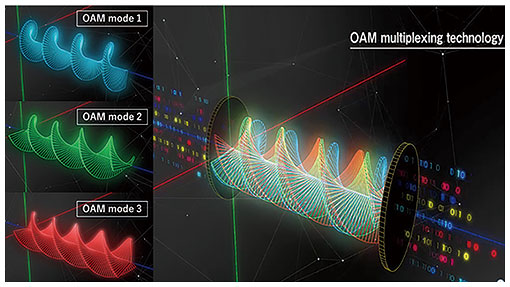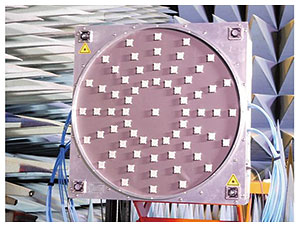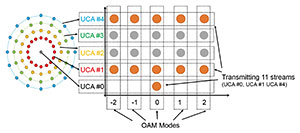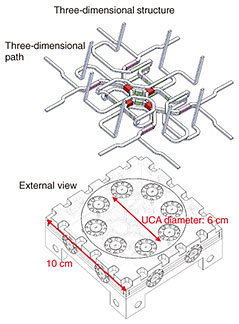 |
|||||||
|
|
|||||||
|
Front-line Researchers Vol. 22, No. 5, pp. 6–11, May 2024. https://doi.org/10.53829/ntr202405fr1  Achieving the World’s Highest Wireless Transmission Rate by Delving into Theories That Appeared about 100 Years AgoAbstractWith the advent of smartphones, mobile communications have rapidly become popular. Fifth-generation mobile communications system (5G) services, which feature high speed, large capacity, low latency, and simultaneous connection to multiple terminals, are spreading, and the 3rd Generation Partnership Project (3GPP), an international standardization organization, has begun initial discussions on 6G. The technological foundation for the advancement of mobile communications is wireless transmission technology. Doohwan Lee, a senior distinguished researcher at NTT Network Innovation Laboratories, and his colleagues achieved the world’s first high-capacity wireless transmission of 1.44 Tbit/s using the sub-terahertz band. We interviewed him about the technology that enabled this achievement, his research themes aiming at exploiting all the properties of radio waves, and his thoughts on the importance of researcher well-being for enabling them to make people happy through research. Keywords: wireless transmission, orbital angular momentum, sub-terahertz band Break through the limits of wireless transmission technology in terms of high speed and high capacity through OAM multiplexing technology—Would you tell us about the research you are currently conducting? I have been researching wireless communications since I was a student and continued after joining NTT. Research on wireless communications covers a wide range of fields—including research on radio-wave propagation, suppression and control of interference, and methods for putting signals on radio waves. In these research fields, I have been pursuing high-speed, high-capacity wireless transmission technology. There have been three directions for achieving high-speed and large-capacity transmission with wireless technology: (i) increase the spatial-multiplexing order through methods such as multiple-input multiple-output (MIMO), (ii) broaden the transmission bandwidth, and (iii) increase the modulation level. However, the technology for increasing the modulation level has almost reached its limit, and although the modulation level can be further increased by 20–30%, it is unlikely that it can be increased 10 or 100 times. Under those circumstances, to increase the spatial-multiplexing order, I thought that a new approach was needed and focused on orbital angular momentum (OAM) multiplexing transmission, which involves applying the principal of OAM to wireless communications. OAM is a physical property of radio waves characterized by the phase of a radio wave rotating on a plane perpendicular to the direction of propagation, and the trajectory of the same phase takes on a helical structure in the direction of propagation (Fig. 1). The number of phase rotations is called an OAM mode. For example, the left of Fig. 1 shows, from top to bottom, the trajectory of the same phase in OAM mode 1, OAM mode 2, and OAM mode 3. Radio waves having the OAM property (hereafter, OAM waves) cannot be received without a receiver having the same OAM mode at the time of transmission. As in the relationship between a nut and bolt, an OAM wave can only be received by receivers with the same helical structure. Accordingly, when multiple radio waves having different OAM modes are transmitted simultaneously, they can be separated without interfering with each other by using a receiver with the same number of phase rotations corresponding to each OAM mode of the transmitted wave. Therefore, by putting a data signal in each OAM mode, multiple different signals can be transmitted in a multiplexing manner [1] (right of Fig. 1). In theory, the OAM mode can be increased infinitely, so the multiplexing order can be increased infinitely. However, an OAM wave tends to spread spatially as the wave progresses, and this tendency becomes more pronounced as the OAM mode increases (i.e., number of phase rotations increases). Owing to this spreading nature of OAM waves, for a fixed-sized receiver antenna, as transmission distance increases, the power of the radio waves that can be received by that antenna decreases. Consequently, the higher the OAM mode (more spreading), the lower the ability to extend transmission distance. In other words, the transmission distance is limited.
Although OAM appeared as a theoretical theory in the early 20th century, it has never been tested in a real environment because technology to implement it had not been established. As wireless communications technology in the high-frequency band has matured, OAM multiplexing transmission using a wide bandwidth in the millimeter-wave band has been demonstrated. Laboratory-level experiments have been reported by the University of Southern California in the USA: they demonstrated 32-Gbit/s OAM multiplexing transmission using the 28- and 60-GHz bands in 2014 and 2016, respectively. In 2018, NTT achieved the world’s first OAM multiplexing transmission with a capacity of 100 Gbit/s over a distance of 10 m using the millimeter-wave band, and in 2020, NTT demonstrated 100-Gbit/s transmission over a distance of 100 m. —You achieved the world’s first 1.44-Tbit/s wireless transmission in the sub-terahertz band through OAM multiplexing transmission technology, right? To extend transmission distance without using higher OAM modes and increase capacity by simultaneously carrying out OAM multiplexing transmission of multiple sets while maintaining the property that radio waves in different OAM modes do not interfere with each other, we devised OAM-MIMO multiplexing transmission technology that combines OAM technology and widely used MIMO technology. We then developed a prototype transceiver for wireless transmission with OAM-MIMO multiplexing transmission technology in the 28-GHz band (Fig. 2).
The prototype transceiver is equipped with four uniform circular array (UCA) antenna elements, which can transmit and receive radio waves in five OAM modes, and one antenna element in the center. With the exception of UCA #0 in the center, UCAs #1 to 4 can generate five OAM modes (–2, –1, 0, 1, and 2) and multiplex radio waves of those OAM modes. Signals multiplexed in the same mode are separated at the receiver by using MIMO technology (Fig. 3). With the configuration of antennas shown in Fig. 3, a total of 21 data signals can be transmitted simultaneously.
Signal processing technology to achieve 100-Gbit/s-class wireless transmission using the prototype transceiver consists of three technologies: (i) adaptive modulation and coding (AMC) that adaptively determines the modulation level and channel-coding rate in consideration of the reception quality of each signal, (ii) transmission-power control technology, and (iii) signal-separation technology on the receiver side. Using these technologies, we achieved error-free 100-Gbit/s wireless transmission of more than 10 multiplexed signals over a distance of 10 m (in 2018) and 100 m (in 2020). We adopted an approach for increasing the spatial-multiplexing order by multiplexing multiple OAM waves using an analog circuit called a Butler matrix. This approach makes it possible to reduce the enormous amount of digital signal processing required to eliminate interference between radio waves in different OAM modes in high-capacity transmission exceeding 1 Tbit/s. We developed an antenna-integrated Butler matrix that operates over a wide bandwidth and with low loss (Fig. 4). The antenna-integrated Butler matrix is designed to simultaneously generate and separate eight different OAM waves over a very wide bandwidth (135 to 170 GHz) in a manner that enables multiplexing and transmission of eight data signals.
To transmit eight OAM waves simultaneously using the Butler matrix, the phase of the radio waves must be controlled with extremely high precision. Since the phase of radio waves varies with frequency, it is extremely difficult to uniformly control the phase over a wide bandwidth by using analog circuits. We therefore analyzed the unique radio-wave propagation in a waveguide, which differs from free space, and devised a phase shifter that can theoretically align the progression of the phase uniformly over a wide bandwidth. By designing a multilayer three-dimensional path (Fig. 5) that includes the aforementioned phase shifter so that all paths are electrically equal in length and planar intersections in the circuit (a factor that degrades performance) are eliminated, we developed a Butler matrix that can provide the necessary phase for each OAM mode over a 35-GHz bandwidth and can transmit eight multiplexed data signals. By transmitting the signals by OAM multiplexing in each of two different polarizations, it is also possible to multiplex and transmit twice as many data signals simultaneously without them interfering.
In March 2023, we used this antenna-integrated Butler matrix for transmission tests that demonstrated the world’s first large-capacity wireless transmission at a total data rate of 1.44 Tbit/s using the sub-terahertz bands of 135.5 to 151.5 GHz and 152.5 to 168.5 GHz. Our goal is to achieve (i) broadband and high-speed wireless transmission comparable to optical transmission systems and (ii) seamless connection between wireless and optical transmission systems without the need for a complex digital-signal-processing system for multiplexing the OAM waves because the analog circuit (Butler matrix) handles the multiplexing of those waves. Going forward, we intend to conduct demonstration tests of OAM multiplexing transmission over longer distances exceeding 100 m while envisioning various applications such as wireless backhaul/fronthaul between base stations and relay transmission. We expect our technologies will support the creation and spread of a variety of future services, such as virtual reality, augmented reality, high-definition video transmission, connected cars, and telemedicine, as a wireless communication technology in the era of the Innovative Optical and Wireless Network (IOWN) and sixth-generation mobile communications system (6G). Research for exploiting all the properties of radio waves—It is an interesting approach to delve into past theories and record the world’s highest data rate. What kind of research will you focus on going forward? Regarding OAM, it has become possible to demonstrate its theory, proposed about 100 years ago, and we are looking forward to its development toward the practical implementation. Radio waves have many other physical properties that have not been exploited or focused on, and I want to make a theme of using those properties to increase the degree of freedom in the use and expand the range of wireless technology. For example, since radio waves can travel only in a straight line, if an obstacle is placed in their direction of travel, it will stop them at that point. Diffraction, which allows a beam of a radio wave to somehow avoid the obstacle and travel beyond it, also occurs. However, a portion of the beam leaks as it wraps around the obstacle, so a technology that bends the beam to avoid the obstacle is being investigated. Radio waves also spread out as they travel, which reduces the received power of the waves, but if the radio wave beam can be narrowed, the received power can be increased. Light is like an extremely high-frequency version of radio waves; however, it has a much narrower beam, such as in a laser, which has not yet been achieved with radio waves. Although interference is often treated as a nuisance in regard to wireless communications, I wonder if we can improve communication efficiency by exploiting it. I believe that by exploring these themes, we will be able to develop wireless communications that have never been conceived of before. As we repeat this research process, I believe we will be able to achieve the ultimate world of fully using all the properties of radio waves and controlling radio waves. I want to play the role of fully using the last remaining property of radio waves. Good ideas are born when you have plenty of energy, which is increased by the state of well-being—Please tell us what you keep in mind as a researcher. I think some people have the impression that to become a leading researcher, you must constantly think about research and immerse yourself in it and be conscious of research in your daily life. Sometimes you need to be immersed in your research, but if that is all you do, when you hit a wall, everything will end there. Rather, I believe that research is born when you have plenty of energy. That is to say, when you are in an unbalanced situation in which you don’t have much time and physical strength, you won’t come up with any ideas for research. Research ideas will only come to fruition if you have the energy and leeway to think of them, both physically and psychologically, in your private and work life. I’ve heard stories of people coming up with good ideas while taking a bath. Many people relax while taking a bath, so it’s a time when they have some free time to think. I once came up with an idea that led to a patent while brushing my teeth! Therefore, I try to live a life that allows me to have plenty of energy. I try to keep my working hours to maintain a good work-life balance, I try to get plenty of exercise and respect for my private and family life. I try not to push myself too hard because I believe that if I can make my situation calm and save my strength, I’ll be happier in my personal life and will be able to come up with research ideas. On a similar note, research on well-being as a use case for 6G is ongoing; however, I think that if you are not in a state of well-being, you cannot carry out research on well-being. I believe that the results of my research can ultimately make society and people happy, and I cannot do research that makes people happy unless I am happy too. It is important to ensure my well-being and enjoy happiness first; then I can do research to make others happy. —Please give a message to younger researchers. As I mentioned above, as you experience the state of well-being, a fulfilling life, and happiness, your research will become unique and fulfilling; as a result, you will also become satisfied, creative, and happy in a manner that creates a virtuous cycle. Therefore, you will be able to enjoy your research. Nevertheless, time is limited, and there are deadlines you must meet. By smartly devising the order of work and the way to proceed, you can create more time, which can be used to do things for the sake of your well-being, thereby leading to a virtuous cycle. That said, what well-being means to you and the rhythm of your life differ from person to person, so the virtual cycle that I’ve talked about does not work for everyone. To create a virtual cycle for yourself, you need to think about the essence of your own well-being and the rhythm of your life. Only you understand yourself; you are the expert on yourself. References
■Interviewee profileDoohwan Lee received a B.S. (Hons.) and M.S. in electrical engineering from Seoul National University, South Korea, in 2004 and 2006, and Ph.D. in electrical engineering and information systems from the University of Tokyo in 2009. He has been with NTT Network Innovation Laboratories since 2009. From 2012 to 2014, he was an assistant professor at the Research Center for Advanced Science and Technology, the University of Tokyo. Since 2016, he has been a part-time lecturer at Kanagawa University. His research interests include compressed sensing, software/cognitive radio, signal processing, and OAM multiplexing. He received the Best Paper Award and Best Technical Exhibition Award from the Institute of Electronics, Information and Communication Engineers (IEICE) Software Radio in 2011, the IEICE Communications Society Excellent Paper Award in 2012, the IEICE SRW (Short Range Wireless Communications) Young Researcher’s Award in 2016, the Best Technical Exhibition Award from SmartCom 2014, the Best Paper Award from SmartCom 2016, the Best Paper Award and Special Technical Award in Smart Radio from IEICE Smart Radio in 2017, and the Distinguished Contributions Award from IEICE Communications Society in 2021. |
|||||||





